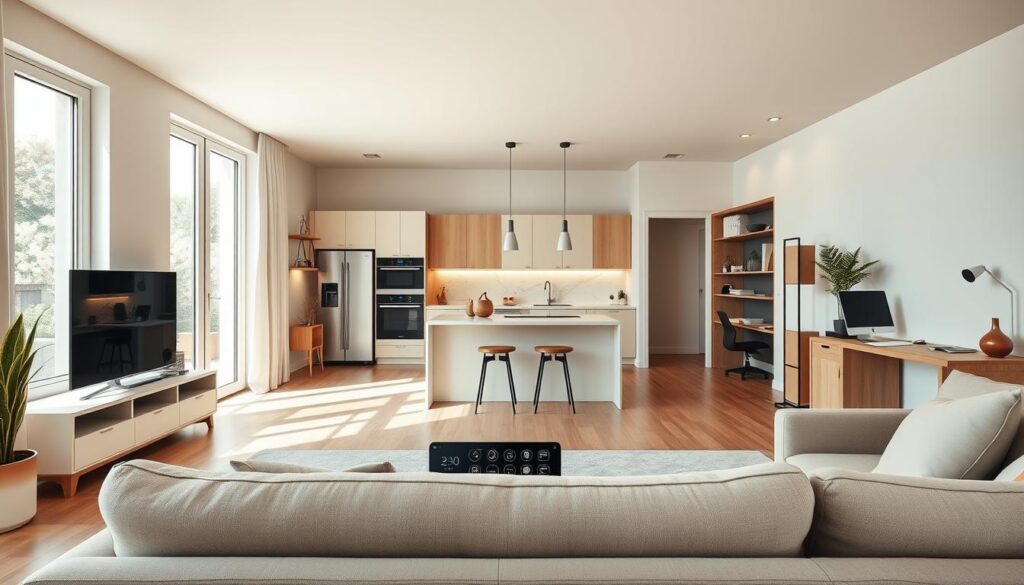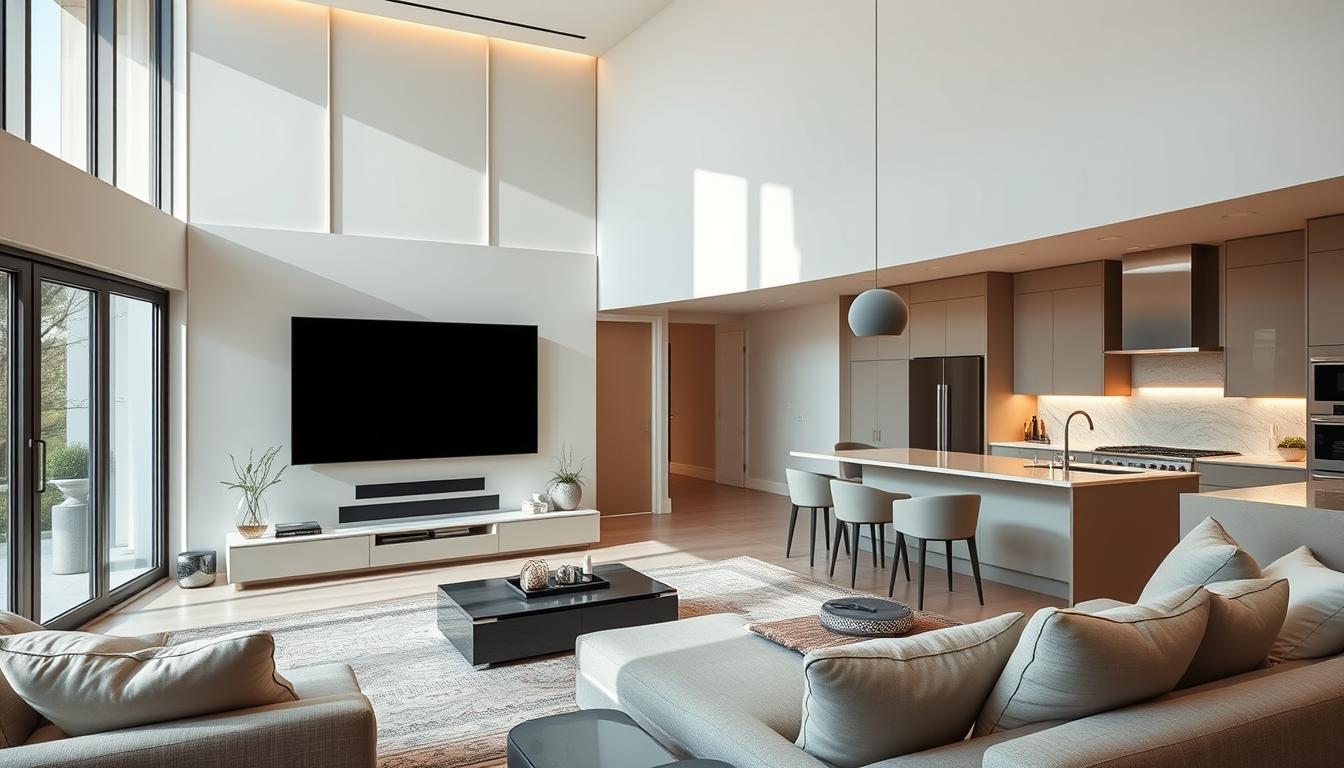Did you know the global smart home market is set to hit $146 billion by 2025? This huge growth marks a big change in how we live and interact with our homes. With technology getting better, making our homes intelligent is now easier and more appealing.
We’re entering a new age in residential design, where tech and beauty mix perfectly. In this detailed guide, we’ll dive into smart living. We’ll share insights and useful tips to turn your home into a modern paradise.
Key Takeaways
- Understanding the basics of smart living and its benefits
- Learning how to integrate technology into your home’s interior
- Discovering practical tips for a seamless smart home experience
- Exploring the future of residential design and its possibilities
- Creating a smart home that is both functional and aesthetically pleasing
What is Smart Home Interior Design?
Smart home interior design mixes technology and style to make homes more comfy and efficient. Homeowners always want to make their homes better. So, smart home design is key.
Definition and Basics
Smart home interior design blends tech into home design and function. It includes smart lights, temperature control, security, and entertainment. It’s about making homes beautiful, functional, and tailored to our needs.
Smart tech makes homes more efficient. For example, smart lights adjust to time and light, saving energy and setting the mood.
Importance of Integrating Technology
Adding tech to home design is vital for a smart home. It’s not just about installing devices. It’s about how they work together for a seamless living space. This boosts home function, energy use, and value.
Smart tech also makes life better. Smart thermostats learn your habits to save energy. Smart security systems keep you safe with alerts and monitoring.
Benefits of Smart Home Design
Smart home design offers many perks, like more comfort and energy savings. It also raises your home’s value. By using smart ideas, you get a stylish and practical space.
- Enhanced convenience through automated systems
- Improved energy efficiency with smart lighting and HVAC
- Increased property value with integrated smart technology
- Advanced security features for peace of mind
Exploring smart home design shows it’s more than a trend. It’s about making homes better for everyone.
Key Features of Smart Home Interiors
Smart home interiors are becoming more popular. They offer convenience and look great. These homes have special features that make them stand out.
They use advanced technology to improve your life. This technology makes life easier and more fun.
Smart Lighting Solutions
Smart lighting is key in modern homes. It lets you control lights from anywhere. You can change brightness and color to match your mood or the time.
For example, smart lighting can wake you up with a sunrise. It also adds beauty to your home. You can set the mood for any event with just a few clicks.
Innovative HVAC Systems
Smart HVAC systems are another important feature. They learn your temperature preferences. This makes your home comfortable all the time.
These systems also save energy. Plus, you can control them from anywhere. So, your home is always ready for you, no matter the weather.
Advanced Security Options
Smart homes have top-notch security. This includes smart locks, cameras, and sensors. You can monitor and control them from anywhere.
With these features, you can watch your home anytime. You’ll get alerts for any unusual activity. This is great for those who travel a lot or have valuable items.
In summary, smart home interiors offer many benefits. They include smart lighting, HVAC systems, and security. These features make your home more comfortable, convenient, and safe. They show off the best smart home decor and modern smart home interiors.
Choosing the Right Technology for Your Home
Smart home devices are now a big part of our homes. It’s important to know how to pick the right technology. With so many choices, it can feel overwhelming. But, by breaking it down, you can make choices that improve your home’s look and function.
Assessing Your Needs
Before you start looking at smart home gadgets, think about what you need. Think about where you spend most of your time and what would make life easier. For example, smart lights can change your living room, while security systems are better for the outside.
First, write down what you want. Do you want to save energy, feel safer, or just make your life easier? Knowing what you need helps you find the right devices for your home.
Popular Smart Devices Available
The market has many smart devices, each for different needs. You’ll find smart thermostats like the Nest Learning Thermostat, smart lighting systems like Philips Hue, and smart speakers like Amazon Echo or Google Home.
Let’s look at some of these devices and their benefits:
| Device | Function | Benefits |
|---|---|---|
| Nest Learning Thermostat | Temperature Control | Energy Efficiency, Personalized Schedules |
| Philips Hue | Smart Lighting | Customizable Lighting, Remote Control |
| Amazon Echo/Google Home | Smart Speaker | Voice Control, Smart Home Integration |
Compatibility Factors to Consider
When picking smart devices, make sure they work well together. Check if they can connect with your current smart home setup. For example, if you have an Amazon Echo, choose devices that work with Alexa.
Here are some things to think about:
- Communication Protocols: Make sure devices use the same protocols like Zigbee, Z-Wave, or Bluetooth.
- Smart Home Hubs: Use a smart home hub to control many devices from one place.
- Brand Compatibility: Some brands offer devices that work well together, making setup easier.
By thinking about what you need, looking at popular devices, and checking compatibility, you can make your home smart and enjoyable. The most important thing is to choose wisely based on your lifestyle and preferences.
Designing a Functional Layout
A well-planned layout is key to a smart home. It boosts both function and looks. When designing, think about how elements work together for a smooth living experience.

Open vs. Closed Spaces
Choosing between open and closed spaces is important. Open spaces make homes feel bigger and more open. They’re great for smart devices and lighting, like smart lighting for home design, which can be controlled easily.
Closed spaces provide privacy. They can be set up for specific uses, like a home office or media room. Smart tech can make these spaces more functional.
Traffic Patterns and Flow
Understanding how people move through your home is crucial. A good layout ensures easy movement and access to smart devices. This makes your home more comfortable and efficient.
For example, smart lighting controls in busy areas make adjusting lights easy. This improves your living experience.
Incorporating Multi-Function Areas
Multi-function areas are trendy in smart home design. They can be used for different things, like a living room that’s also a gym or a kitchen island for dining.
Adding smart lighting for home design to these areas boosts their use. Adjustable lighting can change a space’s purpose quickly, like turning a gym into a relaxing area.
Designing a smart home layout well lets homeowners enjoy their devices more. It creates a space that’s both useful and pleasant to be in.
Selecting Smart Furniture and Decor
Exploring smart home interior design shows us how key furniture and decor choices are. It’s not just about devices; it’s about the furniture and decor we pick.
Furniture and decor are vital in a smart home. They make our homes look good and work well with our smart devices.
Examples of Smart Furniture
Smart furniture changes how we live and interact with our homes. Some examples include:
- Smart sofas with built-in USB ports and charging capabilities
- Adjustable beds with automated settings for comfort
- Coffee tables with wireless charging and integrated smart home controls
Importance of Aesthetic Appeal
Function is important, but our furniture and decor’s look shouldn’t be ignored. A well-designed smart home mixes tech with style, keeping our spaces beautiful and welcoming.
We should pick furniture and decor that are smart and fit our home’s style. This means choosing items with sleek designs, durable and stylish materials, and decor that improves our home’s feel.
Blending Style with Function
Mixing style with function is key to a smart home that looks and works great. This means:
- Understanding our needs and lifestyle to find the right mix of style and function
- Picking furniture and decor that are both smart and look good
- Making sure our smart devices fit in and improve our home’s design
This way, we can have a smart home that’s not just advanced but also a joy to live in.
Creating a Sustainable Smart Home
Designing a smart home that’s eco-friendly is now a top goal. We want to cut down our carbon footprint. Technology can help make our homes more sustainable.
Eco-Friendly Technology Options
Using eco-friendly tech is key to a green smart home. Devices that save energy and reduce waste are important. For example, smart thermostats learn your habits to use less energy.
Some eco-friendly tech includes:
- Energy-saving smart lights
- Smart power strips to cut standby power
- Smart irrigation to save water
These techs make homes sustainable and efficient. They also offer convenience and smart design.
Energy Efficiency in Design
Energy efficiency is crucial in smart home design. Using natural light, insulation, and efficient appliances cuts energy use. Smart systems also track energy use, helping save more.
| Design Element | Energy Efficiency Benefit |
|---|---|
| Natural Light Optimization | Reduces artificial lighting need |
| Insulation | Less heat loss and gain |
| Energy-Efficient Appliances | Uses less energy for better performance |
Smart Automation for Sustainability
Smart automation is vital for sustainable homes. It makes homes run efficiently. For instance, it can turn off lights and adjust thermostats automatically.
“The future of smart homes lies in their ability to integrate technology with sustainability, creating living spaces that are not only intelligent but also environmentally friendly.”
Innovating with smart home ideas is important. We must focus on sustainability. This way, we can have homes that are advanced and good for the planet.

Reliable Connectivity and Infrastructure
A strong network is key for a smooth smart home experience. As we add more devices, we need a stable and fast network.
To ensure a reliable network, understanding its parts is crucial. Strong Wi-Fi is essential, offering the speed and coverage needed for all devices.
Importance of Strong Wi-Fi
A solid Wi-Fi connection is vital for device communication. It’s crucial for devices that need real-time data, like security cameras and smart locks.
To get a strong Wi-Fi signal everywhere, think about mesh networks. These systems use many access points for full coverage, avoiding dead spots and keeping connections stable.
Wired vs. Wireless Solutions
Homeowners often choose between wired and wireless connections. Wired connections are reliable and fast, perfect for important tasks like streaming and servers.
Wireless solutions offer flexibility and ease, letting devices move freely without cables. The best approach is to mix both, using wires for critical tasks and wireless for convenience.
Future-Proofing Your Network
As smart home tech advances, it’s important to prepare your network. Invest in infrastructure that can handle new devices and tech.
Adopting the latest Wi-Fi standards, like Wi-Fi 6, is a smart move. It boosts performance, capacity, and efficiency, readying your network for more devices.
By focusing on reliable connectivity, you build a smart home that’s not just convenient but also ready for future tech.
Personalizing Your Smart Home Experience
A smart home is all about making it your own. You can use modern smart home interiors and gadgets to make your space both useful and beautiful.
Customization Options for Users
Smart homes let you change things to fit your style. You can adjust lights and temperatures to make your home comfy and efficient. For example, smart lights can change color and brightness based on the time or what you’re doing.
Customization options include:
- Personalized lighting scenes
- Custom temperature settings
- Smart home entertainment systems
Integrating Personal Preferences
It’s not just about changing settings. It’s about making your home learn and adapt to you. Gadgets for interior design help you control and watch your home from anywhere.
For instance, smart thermostats can learn your schedule to save energy. Smart security systems can recognize you and alert you to any issues.
| Feature | Benefit | Example |
|---|---|---|
| Smart Lighting | Energy Efficiency | Philips Hue |
| Smart Thermostats | Temperature Control | Nest Learning Thermostat |
| Smart Security | Enhanced Safety | Ring Video Doorbell |
Smart Assistants and Their Roles
Smart assistants like Amazon Alexa and Google Assistant are key to a smart home. They make it easy to control devices with your voice. You can change settings, play music, or even order groceries without touching anything.
The benefits of smart assistants include:
- Voice control for hands-free operation
- Integration with multiple smart devices
- Enhanced accessibility for all users
By using these options, you can make your smart home truly yours. It makes your home better and your life more enjoyable and efficient.
Conclusion: Embracing the Future of Interior Design
As we wrap up our guide to smart home interior design, it’s clear that technology is changing our homes. Smart home automation is not just a trend. It’s a fast-growing field that’s changing how we live and interact with our homes.
Advancements in Smart Technology
Smart homes are getting better with new smart lighting for home design. This makes it easier to set the mood and save energy. Homeowners can now control lights, temperature, and security from anywhere, making life easier and more efficient.
Innovative Design Approaches
We’re all about staying ahead in smart home technology. By using smart home automation, homeowners get a better living experience. It’s about using new tech and designing spaces that are both beautiful and functional.
With the knowledge from this guide, you can make a smart home that looks great and works well. The future of interior design is here, and it’s smarter than ever.


